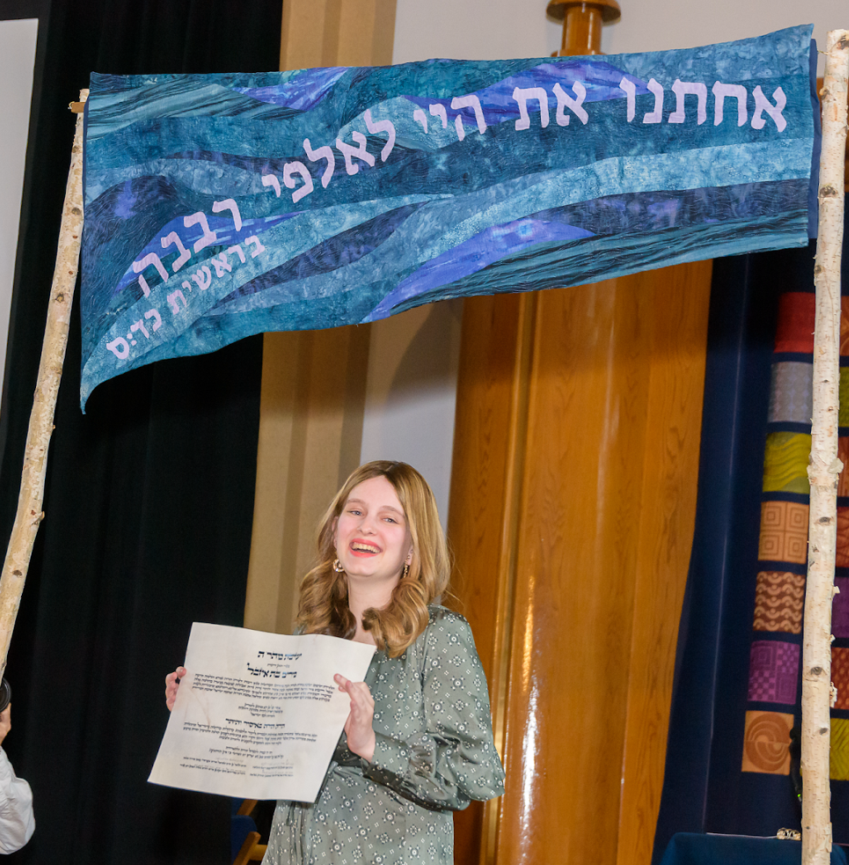In just a few weeks, Maharat will graduate its 100th Orthodox female rabbi, trained to serve 21st-century Jews around the world. Each graduate will walk under a banner decorated with an image of water, symbolizing the ripple effects of our graduates’ Torah knowledge, pastoral training, and powerful leadership. As she passes under the banner, each graduate joins the waves of women who have come before her, all fulfilling the dream of ![]() “Our sister—May you grow into a multitude” (Bereishit 24:60), the blessing originally given to Rivka by her family as she sets out to marry Yitzchak. Revava, according to one midrash (Midrash Torat Kohanim, see Rashi on Lev. 14:49), is a doubling of the word rov, implying not just more, but many many more—tens of thousands more. Multitudes. In another midrash (Midrash Aggadah 24:60:2), Revava references
“Our sister—May you grow into a multitude” (Bereishit 24:60), the blessing originally given to Rivka by her family as she sets out to marry Yitzchak. Revava, according to one midrash (Midrash Torat Kohanim, see Rashi on Lev. 14:49), is a doubling of the word rov, implying not just more, but many many more—tens of thousands more. Multitudes. In another midrash (Midrash Aggadah 24:60:2), Revava references ![]() “leaders of Israel.” Taken together, this pasuk is a hope, a dream of the Biblical Rivka, that all her tens and thousands of descendants will become leaders.
“leaders of Israel.” Taken together, this pasuk is a hope, a dream of the Biblical Rivka, that all her tens and thousands of descendants will become leaders.
This vision is coming to fruition.
Just 16 years ago, Maharat was a nascent idea, a fleeting dream. Only a handful of Orthodox women were looked to as spiritual leaders. 16 years ago, some believed that Orthodox women in the clergy might destroy the fabric of the Orthodox community. Sixteen years ago, women’s Torah scholarship and ritual involvement was relegated to the women’s section.
My own ordination in 2009 was a harrowing and lonely experience. Time and time again, I was shunned, met with rejection, and underestimated. In 2008, about a year before I would get semikha (ordination) from Rabbi Avi Weiss and Rabbi Dr. Daniel Sperber, I was asked to leave the beit midrash where my chavrutah (study partner) and I had been studying. Soon after I received semikha, I was invited and then disinvited to teach Torah in an Orthodox synagogue. In 2010, after teaching in a community, a neighboring rabbi decried my visit, lamenting that “we will have something else to cry about on this Tisha b’Av.”
Today, we have reached a tipping point. We are 100 strong. “Revava—multitudes” of female leaders is a reality.
As we approach this milestone, I reflect on just a few of the many lessons gained from our 16 years and 100 graduates and on how much has changed.
You cannot be what you cannot see
When I was growing up, I did not have a calling to the rabbinate. I never had that “aha moment,” because there was simply no model for Orthodox female clergy. I had not “seen it,” and therefore I didn’t know that Orthodox women in clergy were possible. After I was ordained, that reality changed. In the weeks after my ordination gained public scrutiny, I received a letter from two 11-year-old girls who could now see a different future for themselves. They wrote:
As young Jewish women, we find it exceedingly important that women play roles in clergy and Jewish Orthodoxy so that they can be our role models. We are inspired when we see women playing roles in Jewish life. Now, we can imagine ourselves as leaders in the Orthodox world.
When Sofia Freudenstein, a 2025 Maharat graduate, met me in Toronto when she was just 11 years old, she knew that her destiny was to become a rabbi. Her “aha moment” came because she could imagine what Orthodox female leadership looked like. After she walks beneath Maharat’s graduation banner, Sofia will serve as the Director of Jewish Life and Learning for the Jewish Community of Helsinki, Finland. Today, hundreds of young women are learning Gemara at a high level, at Maharat or other institutions, with the hope of becoming an authority and leader because of the many role models they can now see.
Flourishing of the field
When Maharat opened its doors in 2009 there were few, if any other places that embraced and supported a credentialed pathway towards meaningful leadership for women. Giving women a title of authority that reflected their years of scholarship and leadership was unheard of. Today, the field of high-level learning for Orthodox women, in the US, Israel, and even globally, has flourished. After Maharat began to bestow the degree of semikha, along with a title that conveys “rabbi,” other learned women began to use titles, like rabbanit, regardless of whether their spouses were rabbis.
In Israel, Maharat and Ein Hanatziv opened a joint semikha program in October 2023, called Tehila, where Israeli women will receive semikha. In France, England, and Germany, where Maharat graduates have built thriving spiritual communities of learning and praying, congregants and students have been inspired by their rabbis, rabbas, and rabbanits to seek out ordination for themselves. Even across the US, there are more opportunities for Orthodox women to learn and lead in synagogues, as heads of Jewish organizations, and as principals of schools. Indeed, 2025 may be ”The Year of Orthodox Women.” The field is flourishing.
Names not numbers
One hundred women is significant; as a group, we are a force. Yet, each and every one of our graduates has the privilege and responsibility of impacting thousands. Rabbanit Tamar Eisenstat, a retired lawyer and involved lay leader, now works overnight shifts in her role as a staff chaplain at New York-Presbyterian Queens Hospital. Rabbanit Tamar’s niece, Anna Eisenstat, is currently pursuing ordination at Maharat after earning her Master’s in Theological Studies at Harvard Divinity School. Rabbanit Victoria Sutton inspires young minds with her brilliance as a Talmud teacher and is also director of the Drisha middle and high school summer program for girls. Rabbanit Leah Sarna is the senior Spiritual Leader of Kehillat Sha’arei Orah, an Orthodox synagogue in the Philadelphia suburbs. In a description of her installation, the synagogue wrote:
Our Kehillah, “Sha’arei Orah” (Gates of Light), tries to exemplify illumination in our embrace of forward-thinking Torah, the inclusivity of lay involvement, and now, through the installation of Rabbanit Leah Sarna as our Spiritual Leader, an eye toward a new paradigm in rabbinic leadership.
Each of Maharat’s 100 graduates is like a world unto herself.
At this year’s graduation, there will be many young girls and even boys who will witness this new reality. As each graduate walks underneath that banner, she assumes the mantle of leadership. She joins a dynamic and ever-growing network of Orthodox women who are committed to serving the Jewish people. Today, women are part of the fabric of not only the beit midrash, but also the bimah (pulpit), the classroom, hospitals, and funeral chapels; they are authors of piskei halakha (legal rulings) and heads of religious institutions. “Revava” brings to mind that Maharat graduates have impacted thousands of Jews, teaching Torah in over 50 communities worldwide.
Change takes time, and still, something that just a few years ago was a fleeting dream has become a reality. People can become female Orthodox rabbis, because “you can be what you can see;” the field will continue to grow and flourish; and the impact that each woman had and will have is exponential.
As I look towards the next decade and the vision of: ![]() “Our sister – May you grow into a multitude,” I see a community that celebrates tens of thousands of people who have been impacted by female clergy; a world where men and women will shape our communal conversations, creating a 21st-century Judaism that is relevant, dynamic, and inclusive. At Yeshivat Maharat, we have already begun the journey to ordaining our next 100 Orthodox female rabbis.
“Our sister – May you grow into a multitude,” I see a community that celebrates tens of thousands of people who have been impacted by female clergy; a world where men and women will shape our communal conversations, creating a 21st-century Judaism that is relevant, dynamic, and inclusive. At Yeshivat Maharat, we have already begun the journey to ordaining our next 100 Orthodox female rabbis.

